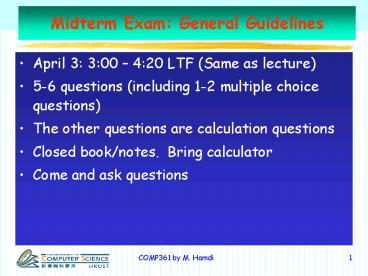Midterm Exam: General Guidelines PowerPoint PPT Presentation
1 / 13
Title: Midterm Exam: General Guidelines
1
Midterm Exam General Guidelines
- April 3 300 420 LTF (Same as lecture)
- 5-6 questions (including 1-2 multiple choice
questions) - The other questions are calculation questions
- Closed book/notes. Bring calculator
- Come and ask questions
2
Problem 1
- Given a channel with an intended capacity of 20
Mbps. The bandwidth of the channel is 3 MHz. What
signal-to-noise-ratio (SNR) is required in order
to achieve this capacity? - Solution
- The maximum number of bits/sec H log2(1 S/N),
- So 20 M 3 M log2(1 S/N).
- We can compute that S/N must be 100.6,
- so 10log10(S/N) 20 dB.
3
Problem 2
- There are 200 computers in a lab which are
attached to an Ethernet (10 Mbps) with a coaxial
cable of 1500 m. The packets are 800 bits long.
The propagation delay is 2108 m/sec. On
average, how many packets can each computer send
per second? - Note the efficiency of the Ethernet is equal to
1/(12a/A), where a propagation
delay/transmission delay and A (1-1/N)N-1,
where N is the number of computers.
4
Solution
- The efficiency of the Ethernet is 1/(15.4a)
where a 0.093. - Efficiency 68.
- Consequently, the packet transmission rate per
computer is equal to (0.68 x 10 x 106)/(200 x
800) 44 packets/sec.
5
Problem 3
- Using the CRC error detection method, let M
10100001, and P 1001. - What is the value of FCS (frame check sequence) ?
- Solution
- Divide 101000010000/1001 you will get
- a remainder of 111 which is the FCS
6
Problem 4
- A group of N stations share a 56 kbps pure ALOHA
LAN. Each station outputs a 1000-bit packet at an
average of one packet every 100 sec. What is the
maximum useful value of N? - Solution
- With pure ALOHA, the usable maximum bandwidth is
0.18 56 kbps 10.1 kbps. Each station requires
10 bps, so N 10100/10 1010 stations.
7
Problem 5
- A channel has a data rate of 10 Mbps and a
propagation delay of 5 microsec/km. The distance
between the sending and the receiving nodes is 50
km. Nodes exchange fixed-size frames of 1000
bits. What is the size of the window needed for a
sliding-window protocol to have the utilization
at 50? What is the size of the sequence number
field? - Solution
- a propagation delay / transmission delay 2.5
- W/(12a) 50
- Solve this equation, we can get that W3, which
requires a sequence number field size of 2 bits.
8
Problem 6
- Given an FDDI local network with 5 stations.
Assume that TTRT has been set up to be equal to
28 seconds where 20 seconds are equally allocated
to the stations for synchronous transmission, and
8 seconds are allocated for asynchronous
transmission. - Assume all stations are fully loaded with
synchronous and asynchronous traffic, and the
propagation delay from one station to the next is
1 second. - If station 1 gets the token at time t4, when
will station 4 have a chance to transmit its
asynchronous traffic?
9
Solution
10
Problem 7
- Answer the following questions pertaining to DLL
- a) For a given link, assume a bit error rate of
10-3 (bit errors are independent and identical)
and a frame size of 125 bytes, what is the
probability of a frame error? - Prframe error 1 - (1 - 10-3)1258 0.6323
- b) Assume a 1 Mbps link of 1000-kilometers in
length with 5 nanoseconds per meter propagation
delay. Assume negligible time for ACK frames and
processing delay. The sender always has data to
send. For Stop-and-Wait (SAW), what is the
minimum frame size required to achieve an
utilization of no less than 75? - tpr 106 5x10-9 5 millisec
- tfr (size / 106) which is (size / 103) for
millisec (size is in bits) - U tfr / (2tpr tfr)
- 0.75 (size / 1000) / (25 (size / 1000)) gt
size 3750 bytes
11
Problem 7
- c) Assume a 1 Mbps link of 1000-kilometers in
length with 5 nanoseconds per meter propagation
delay. Assume constant 250-byte data frames and
negligible time for ACK frames and processing
delay. The sender always has data to send. For
sliding window, what is the minimum possible
window size to achieve an utilization of no less
than 75? - tpr 106 5x10-9 5 millisec
- tfr (250 8) / 106 2 millisec
- U (Ntfr) / (2tpr tfr)
- 0.75 (N 2) / (25 2) gt N 4.5 and taking
the ceiling gt N 5
12
Problem 8
- A Token ring consisting of N computers, each of
which is always ready to transmit packets. When a
station acquires a token, it transmits for T
units of time. - Assume the propagation delay is smaller than the
frame transmission time. The propagation delay is
P units of time. - Derive an expression for the token rotation time,
the time it takes for the token t make one full
circle around the ring - Solution
- Token rotation time N x (T P/N)
13
Problem 9
- A token ring transmits at a rate of 5 Mbps and
has a length of 800 meters. The free token us 24
bits long. The propagation speed is 2 108 m/sec. - A) How many meters of cable is equivalent to a
1-bit delay? - B) For proper operation of the ring, how bit
delays should be inserted by the powered
stations? - Solution
- A) 1/5Mbps d / 2 108 m/sec d 40 m.
- 800/40 20 bits.
- We must add another additional 4 bits by the
stations.

